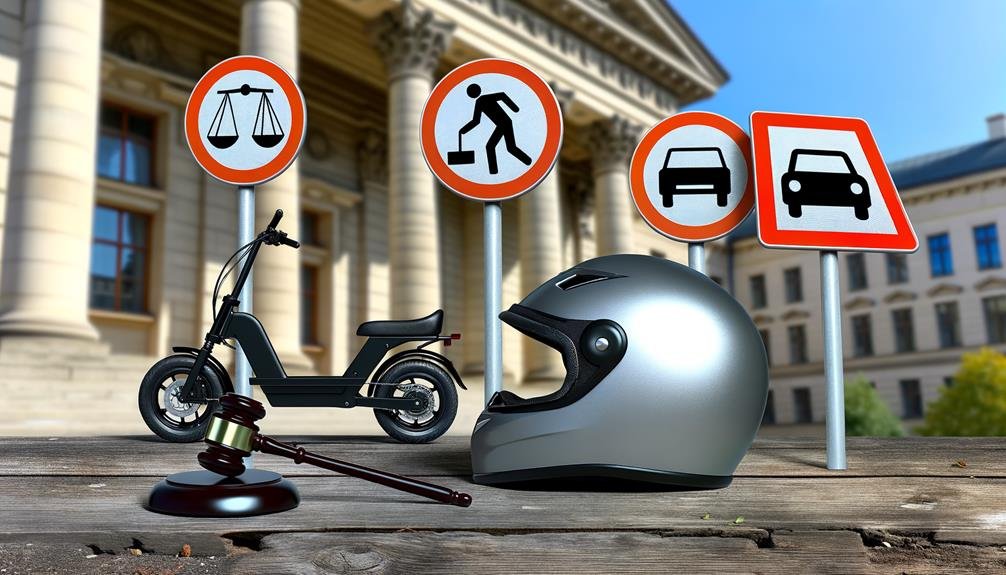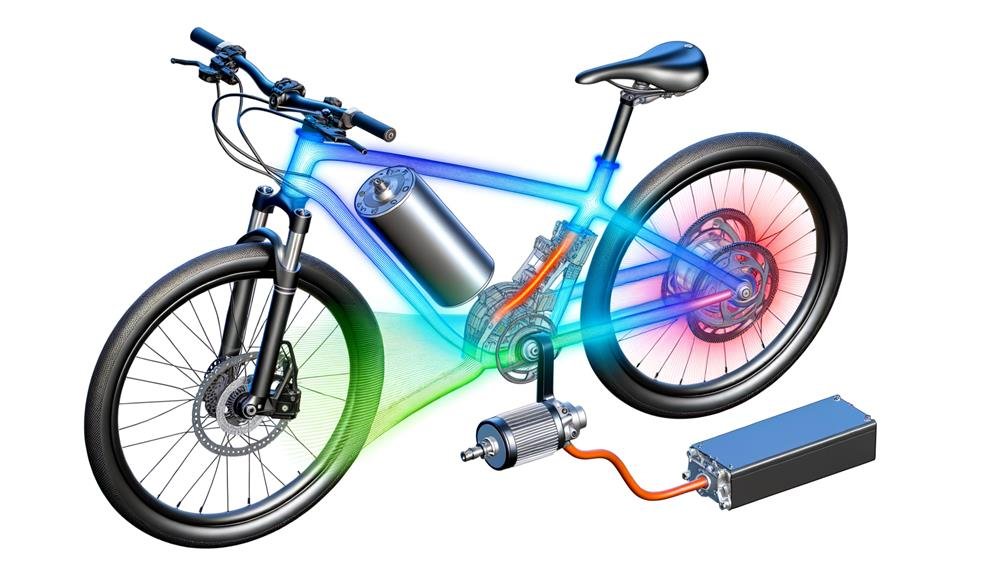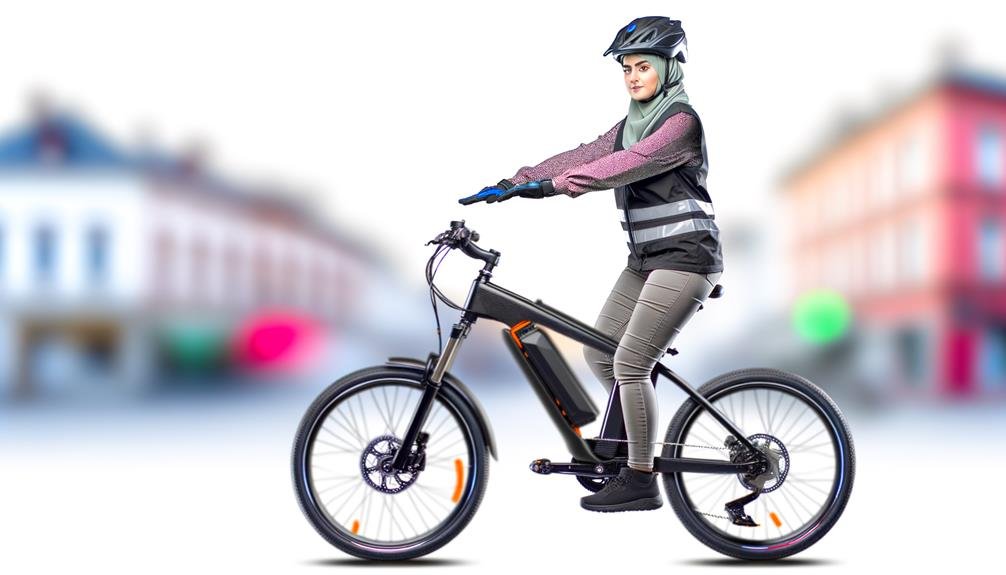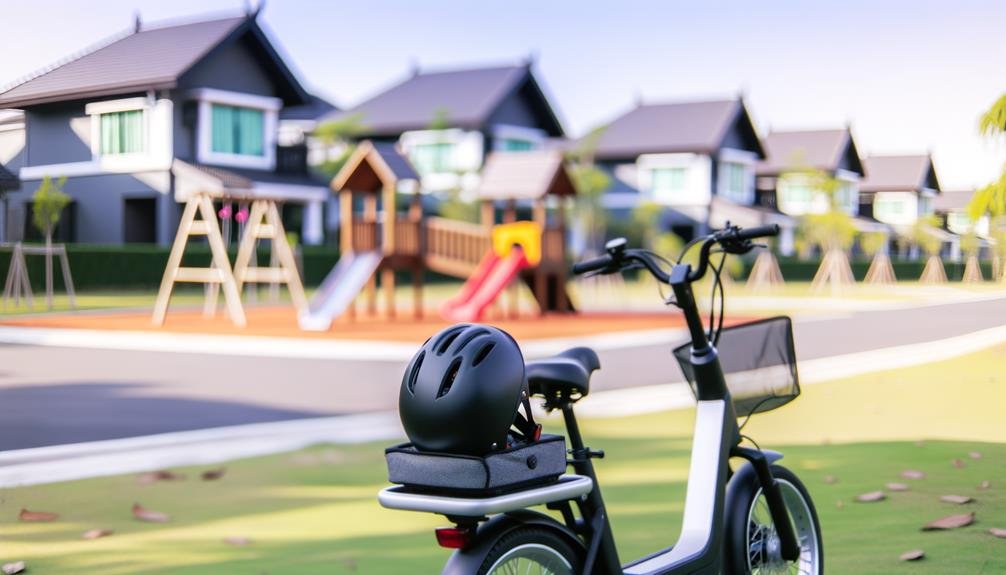Charles Miller is a veteran bike enthusiast with over 12 years of experience dealing with bikes as a mechanic. Despite immense love and expertise for...
Like a symphony merging the beauty of bicycles with the power of electricity, electric bikes, or e-bikes, have entered the transportation stage with a harmonious blend of efficiency and sustainability. We're here to unravel the mystery behind these innovative machines.
How do they work? What sets them apart from regular bikes or motorbikes? In the world dominated by fossil fuels, are e-bikes a viable alternative?
Stick around, the answers might surprise you.
- Key Takeaways
- Understanding Electric Bikes
- The Mechanism Behind E-Bikes
- Choosing Your Ideal E-Bike
- Operating an Electric Bike
- Licensing and Legal Considerations
- E-Bike Speed and Limitations
- Technological Advancements in E-Bikes
- Health Benefits of E-Bikes
- Safety Tips for E-Bike Riders
- Frequently Asked Questions
- Conclusion
Key Takeaways
- Electric bikes are regular bicycles integrated with electrical components such as a motor, battery, and controller.
- E-bikes operate in three modes: Pedal Only, Pedal-Assist, and Electric-Only, allowing riders to tailor the level of electrical assistance to their needs.
- The e-bike motor provides the necessary torque to assist in pedaling, making it easier to tackle obstacles.
- When selecting an e-bike, consider factors such as battery range, motor power and torque, weight and size of the bike, quality of components and frame, and warranty and after-sales service.
Understanding Electric Bikes
When we delve into understanding electric bikes, we find that they're essentially regular bicycles integrated with electrical components such as a motor, battery, and controller, which provide additional assistance to the rider. These components work in unison to help manage obstacles such as hills and headwind, enabling us to travel longer distances with less physical exertion.
Electric bikes, or e-bikes, operate in three modes: Pedal Only, Pedal-Assist, and Electric-Only. These modes allow us to tailor the level of electrical assistance to our needs. We can pedal without assistance, get a boost when needed, or let the electric motor take over completely. For those of us concerned about bureaucracy, e-bikes don't require special registration, license, or insurance, making them a convenient transport option.
E-bikes come in a variety of types including city, mountain, folding, cargo, and hybrid. Each type is designed to cater to our specific riding needs. Not only do we belong, but our desires are recognized and addressed. Plus, we're part of an environmentally conscious community, as e-bikes produce zero emissions during operation.
Understanding electric bikes means understanding a future where convenience, health, and eco-friendliness converge.
The Mechanism Behind E-Bikes
Having grasped the basic understanding of electric bikes, let's now dissect the intricacies of how their key components – the motor, battery, and controller – work together to power these innovative machines.
At the heart of the mechanism behind e-bikes lies the e-bike motor. This component is responsible for providing the necessary torque to assist in pedaling, making it easier to tackle obstacles like hills and headwinds. There are three types of motors: front hub, rear hub, and mid-drive, each offering different performance characteristics to suit various riding styles.
Meanwhile, the battery serves as the energy source, storing electricity that the motor uses. The larger the battery's capacity, the longer the e-bike can operate. It's also necessary to note that the battery's life can be affected by factors like temperature, terrain, and the rider's weight.
Choosing Your Ideal E-Bike

Now, we're moving on to the crucial step of selecting your ideal e-bike.
We'll analyze the different types of e-bikes, their specifications such as range, power, torque, weight, and size, and safety features.
We'll also assess the quality of components, frame, warranty, and after-sales service, to give you a comprehensive guide for making an informed decision.
E-bike Selection Criteria
Choosing the perfect e-bike involves careful consideration of several factors. These factors include the battery's range, the motor's power and torque, the bike's weight and size, the quality of its components and frame, and the warranty and after-sale services offered.
When selecting the best e-bikes, we first assess the battery. We look for a range that matches our riding needs, whether for commuting or leisure.
Next, we evaluate the motor's power and torque for our intended usage. This helps us determine if the e-bike will provide the necessary assistance for our desired riding experience.
We also consider the bike's weight and size for practicality and ease of use. A lighter and more compact e-bike may be easier to maneuver and store.
Furthermore, we scrutinize the quality of components and frame to ensure durability and performance. High-quality components and a sturdy frame can contribute to a smoother and more enjoyable ride.
Lastly, we demand strong warranty and after-sales service to support our investment. A reliable warranty and good after-sales service can provide peace of mind and assistance in case of any issues or concerns.
Comparing Different E-Bikes
After establishing our selection criteria, let's dive deeper into the specifics of different e-bike types – from city to mountain, folding to cargo, and hybrid – to help us pinpoint our ideal e-bike.
In comparing different e-bikes, we should consider:
- The type of e-bike, as the e-bike market offers a variety suited for different riding needs.
- Battery range and power, along with the bike's weight and size.
- The quality of components, frame, and warranty, coupled with after-sales service.
- Safety features like lights, reflectors, and braking systems.
- Pedal-assist functionality, motor power, and levels of assistance.
This examination will ensure we make an informed decision that aligns with our specific requirements, preferences and safety considerations.
Operating an Electric Bike
Understanding the operation of an electric bike involves familiarizing oneself with its three modes: Pedal Only, Pedal-Assist, and Electric-Only, each offering a unique biking experience. When operating an electric bike in Pedal Only mode, it functions like a conventional bicycle—the rider provides all the power. Pedal-Assist mode is a blend of manual and electric power. The bike's motor provides a boost as you pedal, and you can adjust the level of assistance. Electric-Only mode allows you to sit back and let the motor do all the work.
Here's a handy table summarizing the three modes:
| Mode | Operation | Experience |
|---|---|---|
| Pedal Only | Rider provides all power | Traditional biking |
| Pedal-Assist | Motor assists as you pedal | Enhanced biking |
| Electric-Only | Motor provides all power | Effortless riding |
In essence, what is electric bike and how it works is a perfect blend of traditional and future technology. Operating an electric bike is intuitive, with control units that allow for customization based on terrain and energy levels. We're confident you'll enjoy the versatility that these modes offer, ensuring a ride that fits your energy level and mood.
Licensing and Legal Considerations

As we shift our focus to 'Licensing and Legal Considerations', it's important to note that the rules surrounding electric bikes vary widely. Despite the lack of a universal need for special registration or insurance, some states do have specific requirements for e-bike use.
We'll be taking a close look at the regulations and legal requirements to provide a clear understanding of what's expected from e-bike users.
Understanding E-bike Regulations
In navigating the world of e-bikes, it's crucial to know that they don't need special registration, license, or insurance for operation. Understanding e-bike regulations forms an integral part of our journey in uncovering 'what is electric bike and how it works?'.
Here's what you should keep in mind:
- Different states may have specific requirements for e-bike usage, but generally, they follow federal regulations.
- E-bikes enjoy the same privileges as regular bicycles, including using bike lanes.
- While not always mandatory, helmet usage is always recommended for personal safety.
- Contacting e-bike manufacturers can provide additional insights into regulations in your state.
- Although no special registration is needed, adherence to local regulations is essential.
Legal Requirements for E-bikes
While we've established that e-bikes generally don't require special registration or licenses, it's important to delve deeper into the legal considerations that surround their use. The legal requirements for e-bikes dictate they're viewed as regular bikes, provided they adhere to specific speed and motor power conditions. Consequently, they enjoy the same rights, including usage of bike lanes.
However, bear in mind different states might have unique requirements. Most, though, align with federal regulations for e-bikes. So, understanding what's an electric bike and how it works isn't enough. We must also comprehend the legal landscape.
This ensures we not only belong to the e-bike community but also navigate it responsibly and legally.
E-Bike Speed and Limitations
E-bikes, with their typical assistance up to speeds of 20 to 28 mph before motor disengagement, aren't built to function like motorcycles and indeed have set speed limitations. While it's tempting to think that they can go faster, the reality is that e-bikes are designed to keep you safe and within legal speed limits.
Here are some key points about e-bike speed and limitations:
- E-bikes generally offer assistance from the motor until you reach speeds of 20 to 28 mph, after which you're on your own.
- You can tailor the level of assistance to match your preference, from low to high, which will, of course, affect your speed.
- Unlike motorcycles, e-bikes aren't built for speed. They're designed for a balanced blend of speed and enjoyment.
- E-bikes are excellent commuting companions, allowing you to bypass traffic while also getting exercise.
- Federal regulations categorize e-bikes as regular bicycles if they meet certain conditions related to speed and motor power, keeping them within legal boundaries.
Let's remember, speed isn't everything. E-bikes offer us a unique blend of speed, exercise, and enjoyment that other modes of transportation can't match.
Technological Advancements in E-Bikes

As we delve into the realm of e-bike technology, it's clear that rapid advancements, such as lightweight energy-dense batteries and more powerful motors, are revolutionizing the industry. The development of lightweight energy-dense batteries by consumer electronics and automotive industries is a testament to the technological advancements in e-bikes. Manufacturers are now able to produce e-bikes that aren't only lighter but also have a longer range, thanks to these advanced batteries.
The evolution of motors is also worth noting. Take Shimano's new EP8 motor, for example. It's 21% more powerful, 10% lighter, and smaller in size than its predecessors. This combination of power and compactness has significantly improved the performance of e-bikes, making them more accessible and appealing to a broader market.
The competitive landscape and increasing demand are propelling the industry forward, driving innovation and reducing prices. Enhanced energy density in batteries will further improve the range without increasing mass. Frame designers are also reaping the benefits of these advancements, as they can now easily integrate e-bike functionality into new or existing models.
Health Benefits of E-Bikes
Delving into the health benefits of e-bikes, it's clear that they offer a multitude of advantages, from improving cardiovascular fitness to regulating blood sugar levels. An E-bike provides the opportunity for exercise, even for those who may not traditionally engage in physical activities.
The health benefits of e-bikes are ample and diverse:
- Riding an e-bike is a form of exercise, contributing to cardiovascular health and better blood sugar regulation.
- E-bikes allow individuals, regardless of fitness level, to ride longer and further, leading to increased overall physical activity.
- Even active individuals can benefit from e-bikes as it burns calories and boosts overall activity levels.
- Regular e-bike usage can enhance endurance and confidence, fostering longer trips and promoting overall wellness.
- E-bikes offer a low-impact form of exercise, reducing strain on joints and muscles, making it a suitable activity for a wide range of people.
In essence, e-bikes not only offer an environmentally-friendly and efficient mode of transport, but also pave the way to a healthier lifestyle. They provide a sense of belonging, catering to all fitness levels and age groups, making the journey towards health accessible and enjoyable for everyone.
Safety Tips for E-Bike Riders

While riding an e-bike, it's crucial to prioritize safety by adhering to certain guidelines and precautions. As a community of electric bicycle enthusiasts, we must look out for each other and ourselves. After all, enjoyment and safety go hand in hand.
Let's take a look at some safety tips for e-bike riders:
| Protective Gear | Traffic Laws | Maintenance |
|---|---|---|
| Always wear a helmet and other safety gear. This reduces the risk of serious injury in case of an accident. | Follow traffic regulations meticulously. Electric bicycles must adhere to the same rules as traditional bikes. | Regularly check your e-bike for any issues. This ensures a safe and smooth ride. |
| Make use of lights and reflectors for visibility, particularly in low-light conditions. | Stay alert to your surroundings. Be especially cautious of other vehicles and pedestrians. | Keep your e-bike in tip-top shape. Regular maintenance prevents unexpected issues on the road. |
Frequently Asked Questions
Do You Still Have to Pedal an Electric Bike?
Yes, we still have to pedal an electric bike. The pedal assistance mechanics aid us, making the ride easier. It's a great way to reap e-bike exercise benefits while enjoying the journey.
How Does an Electric Bike Work?
We're examining how an electric bike works. It's simple: through motor efficiency and battery longevity, the bike provides pedaling assistance. You pedal, it engages the motor, and the battery provides sustained power. It's teamwork in motion!
What Is the Difference Between an E-Bike and an Electric Bike?
We're tickled by the thought of differences between an e-bike and electric bike! In reality, they're the same, both subject to e-bike regulations and showcasing electric bike innovation. Now, isn't that a hoot?
Do You Need Anything to Ride an Electric Bike?
We don't need bike licensing requirements to ride an electric bike. However, for our safety, we should wear a helmet and use reflective gear. Always remember, e bike safety measures are crucial for our wellbeing.
Conclusion
In sum, we've demystified the workings of e-bikes, highlighting their impressive mechanisms and advantages. They aren't just bikes with motors, but refined technological creations that blend tradition with innovation.
However, it's not all about speed and convenience. E-bikes also present a softer impact on our environment, making them a savvy choice for those seeking a greener commute.
As advancements continue, we anticipate an even brighter future for e-bikes in our transportation landscape.

Charles Miller is a veteran bike enthusiast with over 12 years of experience dealing with bikes as a mechanic. Despite immense love and expertise for his Tacoma, he rides his Trek Ebike more. Anytime you meet him, you’ll either hear him talking about Bikes, or writing about all things bikes and cars on this blog.
More Posts


